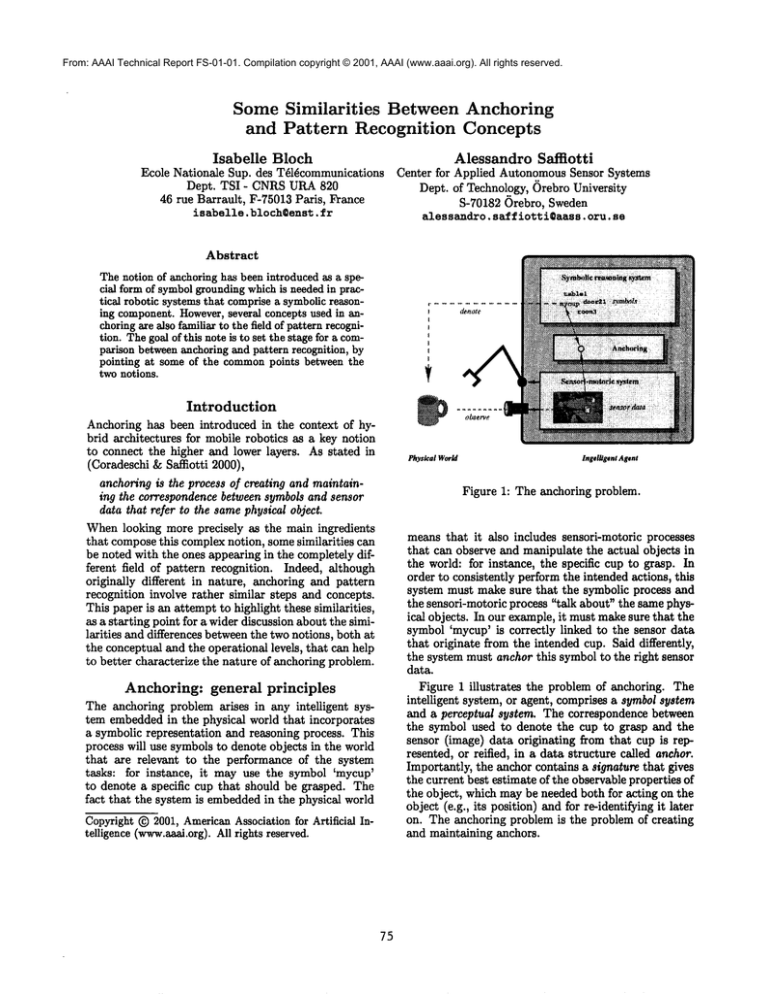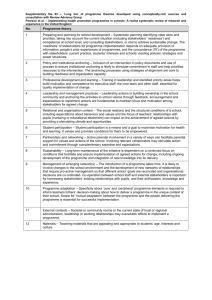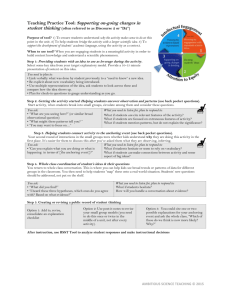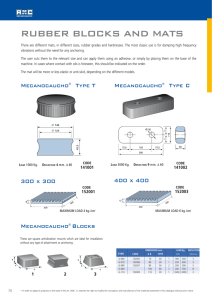
From: AAAI Technical Report FS-01-01. Compilation copyright © 2001, AAAI (www.aaai.org). All rights reserved.
Some Similarities
Between Anchoring
and Pattern Recognition Concepts
Isabelle
Bloch
Alessandro
Safliotti
Ecole Nationale Sup. des Tdldcommunications Center for Applied AutonomousSensor Systems
Dept. TSI- CNRSURA820
Dept. of Technology, {~rebro University
46 rue Barrault, F-75013Paris, France
S-70182 ()rebro, Sweden
isabelle,
bloch@enst,
fr
alessandro,
saffiotti@aass,
oru.so
Abstract
The notion of anchoringhas been introduced as a special formof symbolgroundingwhichis neededin practical robotic systemsthat comprisea symbolicreasoning component.However,several concepts used in anchoringaxe also familiar to the field of pattern recognition. Thegoal of this note is to set the stage for a compaxison betweenanchoringand pattern recognition, by
pointing at some of the commonpoints between the
twonotions.
Introduction
Anchoring has been introduced in the context of hybrid architectures for mobile robotics as a key notion
to connect the higher and lower layers. As stated in
(Coradeschi & Saffiotti 2000),
anchoring is the process of ereatin9 and maintaining the correspondence between symbols and sensor
data that refer to the samephysical object.
Whenlooking more precisely as the main ingredients
that composethis complexnotion, somesimilarities can
be noted with the ones appearing in the completely different field of pattern recognition. Indeed, although
originally different in nature, anchoring and pattern
recognition involve rather similar steps and concepts.
This paper is an attempt to highlight these similarities,
as a starting point for a wider discussion about the similarities and differences betweenthe two notions, both at
the conceptual and the operational levels, that can help
to better characterize the nature of anchoring problem.
PhysicalWorm
IngMllgant
Agent
Figure 1: The anchoring problem.
Anchoring:
general
principles
The anchoring problem arises in any intelligent system embeddedin the physical world that incorporates
a symbolic representation and reasoning process. This
process will use symbolsto denote objects in the world
that are relevant to the performance of the system
tasks: for instance, it may use the symbol ’mycup’
to denote a specific cup that should be grasped. The
fact that the system is embeddedin the physical world
Copyright(~) 2001, AmericanAssociationfor Artificial Intelligence (www~i.org).All rights reserved.
75
meansthatit alsoincludes
sensori-motoric
processes
thatcanobserve
andmanipulate
theactualobjects
in
theworld:
forinstance,
thespecific
cupto grasp.
In
ordertoconsistently
perform
theintended
actions,
this
systemmustmakesurethatthesymbolic
process
and
thesensori-motoric
process
"talkabout"
thesamephysicalobjects.
In ourexample,
it mustmakesurethatthe
symbol
’mycup’
is correctly
linked
to thesensordata
thatoriginate
fromtheintended
cup.Saiddifferently,
thesystem
mustanchor
thissymbol
to therightsensor
data.
Figure
1 illustrates
theproblem
of anchoring.
The
intelligent
system,
or agent,
comprises
a symbol
system
anda perceptual
system.
Thecorrespondence
between
thesymbolusedto denotethe cupto graspandthe
sensor
(image)
dataoriginating
fromthatcupis represented,
or reified,
in a datastructure
called
anchor.
Importantly,
theanchor
contains
a signature
thatgives
thecurrent
bestestimate
oftheobservable
properties
of
theobject,
whichmaybe needed
bothforacting
onthe
object
(e.g.,
itsposition)
andforre-identifying
itlater
on.Theanchoring
problem
is theproblem
of creating
andmaintaining
anchors.
Symbolicdescriptions fromthe symbolsystem
.predict
t
Perceptual
signaturesfl, omthe perceptual
system
Figure 2: Updating of an anchor.
In (Coradeschi &Saffiotti 2000), the authors propose
a computational model of anchoring that comprises
three main ingredients: a symbol system, a perceptual
system, and a predicate g~vunding relation. The latter encodes the correspondencebetween observable features, like the average RGBvalue, and symbolic predicates, like ’red’. Noassumptionis madeon the origin of
this relation: for instance, it can be hand-codedby the
system designer, or it can be learned from a numberof
samples. The task of anchoring is to use this relation
to connect symbols that denote objects, and individual
percepts. For instance, supposethat ’red’ is predicated
of ’mycup’, and that the average RGBvalues of a given
region in an image match the predicate ’red’ according
to the predicate grounding relation. Then that region
1could be anchored to the symbol ’mycup’.
In practice, the task of anchoring has been decomposed into three main functionalities: FIND,that establishes an anchor for a symbolthe first time; TRACK,
that maintains this anchor with time while the object
is kept under continuous observation; and REACQUIRE,
that re-establishes an anchor for an object that has not
been observed for some time. The FINDfunctionality
operates as in the exampleabove.
The TRACK
and REACQUIRE functionalities
continuously update the anchor when new percepts are observed, or simply to account for the passage time. (This
is especially important in dynamicenvironments, where
objects may move around.) Updating is based on
combination of prediction and new observations, as illustrated in Figure 2. The main outcome of the update is the computation of new signature, which may
be used, for instance, to guide action, or for future
matches.
There are more subtleties involved in the notion of
anchoring, including the possibility of partial matching,
of uncertain matching, and of combininganchoring with
active perception. Weaddress the reader to the above
cited papers for more on these issues. For the goals of
this note, however,the basic elementsgiven here suffice.
1In a more realistic
example, several other properties
will
be true of ’mycup’and should thus be checkedin the percept, including the fact of being cup-shaped.
76
Pattern
recognition:
general
principles
Pattern recognition can be expressed in a very general
wayas a representation and decision problemfor interpreting data provided by sensors (Duda & Hart 1973;
Dubuisson1990; Pavel 1993). Interpretation can be understood as categorizing a perceived phenomenonand
attributing it to a family of similar phenomenaor to
an individual knownphenomenon(generic versus specific object recognition). Givena pattern or a form, the
problem amountsto find to which class (or prototype,
or typical form) it has to be attached, or, the other
way around, find in a set of data (in an image for instance) the object that corresponds to a given class.
system performing this task should have learning and
adaptivity capabilities. A key point is the choice of the
representation.
Usually two types of approaches are distinguished,
although this classification is far from being crisp. The
first class consists of statistical pattern recognition. A
pattern is considered as a point in a representation
space defined by a set of features or parameters. Prototypes are points or regions of this space which are
representative of the classes.
The second class consists of structural pattern recognition. This approach is also called descriptive, and the
description should also reflect the structure of the scene
or of the patterns and classes, in a symbolic form.
The most important concepts in pattern recognition
are:
¯ Formsor patterns: these are the actual entities to be
recognized.
¯ Classes and prototypes: knownor learned models of
the objects to be recognized (can be generic or specific: for instance in brain imaginga generic class can
be all grey matter structures, while a specific one can
be the right candate nucleus. Both can be considered
simultaneously or successively, in order to focus progressively on morespecific objects, see e.g. (G~raud,
Bloch, &Maitre 1999)).
¯ Knowledge,information, observations: usual distinctions betweenthese terms occur also in pattern recognition. Observations are related to facts, at a given
time, and deliver what is called accessible information, which can be of numerical or symbolic nature.
Global or prior knowledgeabout classes and prototypes relies on the past, and is often incomplete.
Features is the most often used term for designating information extracted from the data on which
the recognition will be based (typically it concerns
characteristics of the objects that are relevant for the
recognition purpose).
¯ Representation space: its choice is crucial, it should
be informative enough to allow for a good precision
during the identification step, and condensedenough
to avoid unnecessaryredundancy;this raises the classical problem of antagonism between precision and
exactness on the one hand, and mathematical and
algorithmical possibilities on the other hand.
¯ Invariance under transformation, equivalence with respect to transformations or metrics: these concepts
are important whenconsidering that the observed objects can be deformedwith respect to the model(this
can be simply a translation or a rotation, but also deformations induced by the acquisition system, by the
view point, by artifacts or noise, and so on).
¯ Learning: a very important feature of a pattern
recognition system. It alms at defining the classes
or the prototypes in the representation space.
¯ Adaptivity: a requirement for dealing with incomplete knowledge,with systems evolving in time, etc.;
we should carefully note that this term has a very
broad meaning and may concern the model or its parameters, as well as the observations, or even the correspondence between models and observations.
¯ Interpretation and decision: the core of the recognition. It establishes the correspondence between
observed objects and prototypes or classes. If characteristics of data and of classes are mappedin a
commonrepresentation space, the problem amounts
to define similarity functions, equivalence relations,
boundaries between classes, etc. If the representation spaces are different for modelsand for data, the
problemis more difficult and requires to define correspondence functions between both types of representations before decision rules can be designed.
¯ Reject: this notion allows not to decide (or to postpone the decision until moreinformation is available)
either if the object is ambiguous, midwaybetween
several classes (reject in ambiguity) or to far from
all prototypes (reject in distance), the second class
leading typically to creation of new classes or to no
decision at all. Attention should be paid to the fact
that rejected objects do not form a class, but possibly
several ones (or just noise) and therefore reject can
not be treated in the same wayas any other class.
Let us mention two domains where adaptivity is required. The first one concerns active vision and active object recognition (Aloimonos, Weiss, & Bandyopadhyay 1987; Bajcsy 1988), where the purpose is
to actively determine the identity of an object (or
search for a particular object in a scene) by acquiring successive information in order to resolve ambiguities. This often also involves a fusion step for merging
the pieces of information when they becomeavailable.
Examples can be found in (Hutchinson & Kak 1992;
Kovacic, Leonardis, & Pernus 1998).
The second example concerns diagnosis of complex
systems (Dubuisson 1990), which alms at assessing the
functioning modeof a system as well as its evolution
in time. Adaptivity is required to account for possible
new functioning modesor to update characteristics of a
knownmode. Recognizing functioning modes includes
state estimation. Diagnosis of complex systems can be
seen from the point of view of pattern recognition and
the reference (Dubuisson1990) entirely deals with this
point of view. Therefore, diagnosis, state estimation,
and assessing the functioning modeof a complex dynamic system can be considered as examples of pattern
recognition problems.
Parallels
between anchoring
and pattern
recognition
Fromthe previous description of both fields we can exhibit somesimilarities. Wecan see anchoring as a pattern recognition problem, where the models are specific
(rather than generic), and where the recognition process is model-drivenrather than data-driven, i.e. we do
not start from the observed object and try to attach it
to a class, but we look at an object that matches the
description of one specific model. The two ways of reasoning are not symmetrical, since when starting from
the model, the object can be sensed in order to gather
features that are relevant for recognizingthis particular
class. For instance if the modelis described in terms of
shapes, it might be unnecessary to acquire information
about color.
The symbol system can be assimilated to the classes
and prototypes, while the perceptual systems can be
assimilated to the objects to be recognized. In both
domaln.%classes and objects are described in terms of
features, characteristics, attributes. Knowledgeis attached to the symbolsystem, while observations are attached to the perceptual system. Anchoring focuses on
symbolic descriptions of individual models, whichcorresponds to problems in pattern recognition where models
and observations are given under different representations. The predicate grounding relation corresponds to
the notion of similarity used in pattern recognition (in
this case between a symbolic predicate and an attribute
value), or mappingbetween different representations.
The notion of representation space is also a key point
in anchoring.
The notion of invariance under transformations, or of
equivalence with respect to sometransformations is not
explicitly mentioned in the anchoring concepts. However, it can be arguedthat this is implicitly included in
the symbolicdescriptions, as well as in the notion of an-
77
chor signature. For the signature, in manycases these
will be implicitly assumedto be independentof the view
point. Andfor the description, in most cases the fact
that the model description is symbolic automatically
implies invariance under some types of transformations
(like geometrical ones), as it appears in the examples
given in (Coradeschi &Safllotti 2000).
Learning can play several roles in anchoring, as discussed in (Coradeschi & Safllotti 2001), although this
point is still at a very preliminary stage of development.
Interpretation and decision correspond to the task
FINDin anchoring, while reject can be assimilated to
the conclusion FAIL(see algorithm in (Coradeschi
SatBotti 2000)). This notion is not muchdeveloped
the work on anchoring, and it could be interesting to
see if the distinction between reject in ambiguity and
reject in distance could bring somethingto this domain.
An essential aspect of anchoring is its dynamicside,
that is, the fact that we must maintain the symbolpercepts correspondence as time evolves. This aspect
is provided by the TRACKand REACQUIRE functionaiities. It is still unclear in our opinion if this aspect
can find a direct correspondent in pattern recognition.
On the one hand, these functionalities are related to
the notion of adaptivity, since they modifythe interhal signature in the anchor which can be interpreted
as a model of the object (pattern) that we are trying
to track (recognize) -- and this signature will be used
for matching new percepts. On the other hand, these
functionalities do more than simply updating the internal signature in the anchor: they perform tasks like
data association (decide which percepts to use to update each anchor), state estimation (computingthe best
estimate of the observable properties), and data filtering using high-level information -- see the examples
given in (Coradeschi & Sat~otti 2000). Moreover, the
the anchor signature is not simply concerned with the
matchingprocess, but contains for instance information
needed by the controller for operating on the object.
Discussion
Anchoring, as defined in (Coradeschi & Sal~otti 2000),
must necessarily take place in any intelligent embedded
system that comprises a symbolic component. However,
only recently people have attempted to state anchoring
as a problemper se, and the definition of anchoring is
still somehowelusive. Wehope that the above notes
may contribute to the discussion at this Symposium,
leading to a more precise characterization of the anchoring problem, of its relations to other problems, and
of its peculiarities.
In particular, establishing the differences and similarities between anchoring and pattern recognition is important in order to assess which results and experience
could be profitably transferred, and which complementarities could be exploited. Anespecially interesting aspect is the possibility to transfer ideas and techniques
from anchoring to pattern recognition about the use of
78
high-level heuristics and knowledge, including human
knowledge.
Although several aspects of anchoring have corresponding concepts in pattern recognition, the dynamic
aspects of it seemto be closer to other fields like (recursive) state estimation and data association. Wecan
claim that anchoring needs to incorporate techniques
both from pattern recognition and from state estimation, but it puts a greater emphasison the close integration between these and on the use of symbolic models.
References
Aloimonos,J.; Weiss, I.; and Bandyopadhyay,A. 1987.
Active Vision. In First International Conference on
ComputerVision, 35-54.
Bajcsy, R. 1988. Active Perception. Proceedings of
the IEEE 76(8):996-1005.
Coradeschi, S., and Safflotti,
A. 2000. Anchoring Symbols to Sensor Data: Preliminary Report. In Proc. of the I7th AAAI Conf., 129135. Menlo Park, CA: AAAI Press. Online at
http: / /www.aass.oru.se/’asat~o /.
Coradeschi, S., and Saltlotti, A. 2001. On the Role of
Learning in Anchoring. In AAAI Spring Symposium
on Learning Grounded Representation.
Dubuisson, B. 1990. Diagnostic et reconnaissance des
fovmes. Paris: Hermes.
Duda, R., and Hart, P. 1973. Pattern Classification
and Scene Analysis. New-York:Wiley.
G~raud, T.; Bloch, I.; and Maitre, H. 1999. Atlasguided Recognition of Cerebral Structures in MKI
using Fusion of Fuzzy Structural Information. In
CIMAF’99Symposiumon Artificial Intelligence, 99106.
Hutchinson, S. A., and Kak, A. C. 1992. Multisensor Strategies using Dempster-Shafer Belief Accumulation. In Abidi, M. A., and Gonzalez, R. C., eds.,
Data ~usion in Robotics and Machine Intelligence.
Academic Press. 165-309.
Kovacic, S.; Leonardis, A.; and Pernus, F. 1998. Planning Sequences of Views for 3D Object Recognition.
Pattern Recognition 31(10):1407-1417.
Pavel, M. 1993. Fundamentalsof Pagern Recognition.
New-York: Marcel Dekker.




